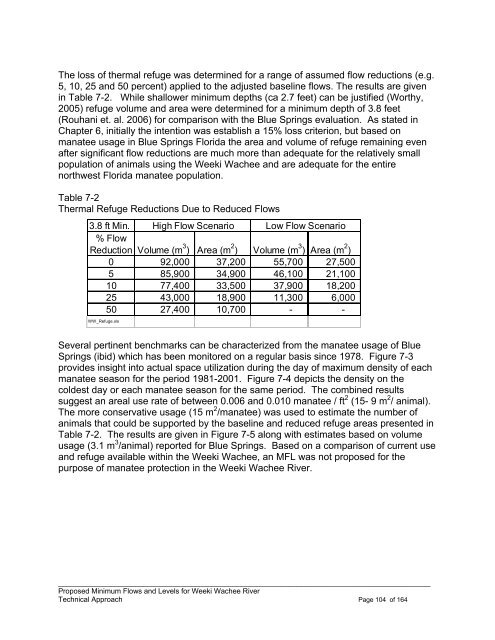Weeki Wachee River System Recommended Minimum Flows and ...
Weeki Wachee River System Recommended Minimum Flows and ...
Weeki Wachee River System Recommended Minimum Flows and ...
You also want an ePaper? Increase the reach of your titles
YUMPU automatically turns print PDFs into web optimized ePapers that Google loves.
The loss of thermal refuge was determined for a range of assumed flow reductions (e.g.<br />
5, 10, 25 <strong>and</strong> 50 percent) applied to the adjusted baseline flows. The results are given<br />
in Table 7-2. While shallower minimum depths (ca 2.7 feet) can be justified (Worthy,<br />
2005) refuge volume <strong>and</strong> area were determined for a minimum depth of 3.8 feet<br />
(Rouhani et. al. 2006) for comparison with the Blue Springs evaluation. As stated in<br />
Chapter 6, initially the intention was establish a 15% loss criterion, but based on<br />
manatee usage in Blue Springs Florida the area <strong>and</strong> volume of refuge remaining even<br />
after significant flow reductions are much more than adequate for the relatively small<br />
population of animals using the <strong>Weeki</strong> <strong>Wachee</strong> <strong>and</strong> are adequate for the entire<br />
northwest Florida manatee population.<br />
Table 7-2<br />
Thermal Refuge Reductions Due to Reduced <strong>Flows</strong><br />
3.8 ft Min.<br />
% Flow<br />
High Flow Scenario Low Flow Scenario<br />
Reduction Volume (m 3 ) Area (m 2 ) Volume (m 3 ) Area (m 2 )<br />
0 92,000 37,200 55,700 27,500<br />
5 85,900 34,900 46,100 21,100<br />
10 77,400 33,500 37,900 18,200<br />
25 43,000 18,900 11,300 6,000<br />
50 27,400 10,700 - -<br />
WW_Refuge.xls<br />
Several pertinent benchmarks can be characterized from the manatee usage of Blue<br />
Springs (ibid) which has been monitored on a regular basis since 1978. Figure 7-3<br />
provides insight into actual space utilization during the day of maximum density of each<br />
manatee season for the period 1981-2001. Figure 7-4 depicts the density on the<br />
coldest day or each manatee season for the same period. The combined results<br />
suggest an areal use rate of between 0.006 <strong>and</strong> 0.010 manatee / ft 2 (15- 9 m 2 / animal).<br />
The more conservative usage (15 m 2 /manatee) was used to estimate the number of<br />
animals that could be supported by the baseline <strong>and</strong> reduced refuge areas presented in<br />
Table 7-2. The results are given in Figure 7-5 along with estimates based on volume<br />
usage (3.1 m 3 /animal) reported for Blue Springs. Based on a comparison of current use<br />
<strong>and</strong> refuge available within the <strong>Weeki</strong> <strong>Wachee</strong>, an MFL was not proposed for the<br />
purpose of manatee protection in the <strong>Weeki</strong> <strong>Wachee</strong> <strong>River</strong>.<br />
____________________________________________________________________________________________<br />
Proposed <strong>Minimum</strong> <strong>Flows</strong> <strong>and</strong> Levels for <strong>Weeki</strong> <strong>Wachee</strong> <strong>River</strong><br />
Technical Approach Page 104 of 164
















